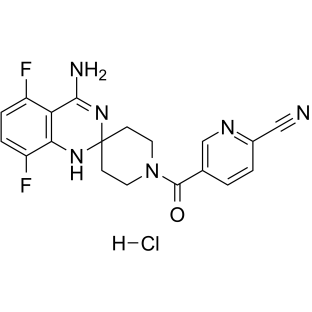1781934-50-6
| Name | AR-C102222 hydrochloride |
|---|
| Description | AR-C102222 hydrochloride is a potent, competitive, orally active and highly selective inducible nitric oxide synthase (iNOS) inhibitor, with an IC50 of 37 nM[1]. AR-C102222 hydrochloride has antinociception and anti-inflammatory activities[2]. |
|---|---|
| Related Catalog | |
| In Vivo | AR-C102222 (3, 10, 30, 100 mg/kg, P.O.) attenuates arachidonic acid-induced ear inflammation and possesses anti-inflammatory activity[2]. AR-C102222 shows good efficacy in a rat adjuvant-induced arthritis model[3]. Animal Model: Male Balb/c mice (20-25 g)[2]. Dosage: 3, 10, 30, 100 mg/kg. Administration: P.O. 55 min before the administration of 0.6% acetic acid (i.p., 1 mL/100 g volume). Result: Significantly inhibited arachidonic acid-induced ear inflammation following a dose of 100 mg/kg of has a maximal inhibition of approximately 79%. |
| References |
| Molecular Formula | C19H17ClF2N6O |
|---|---|
| Molecular Weight | 418.83 |
